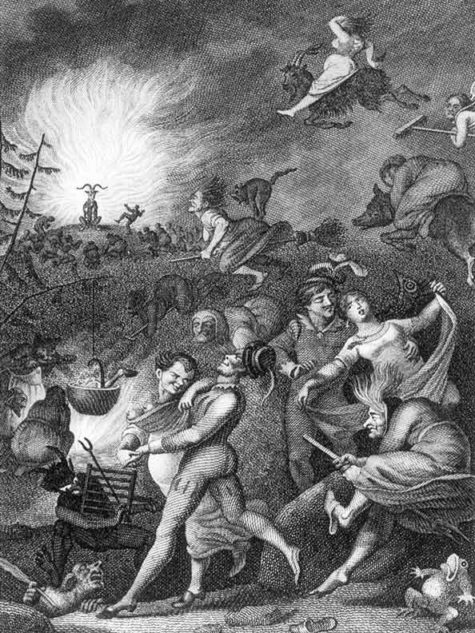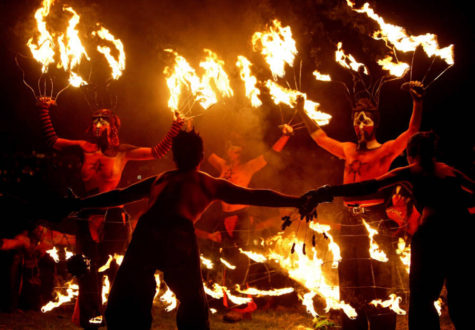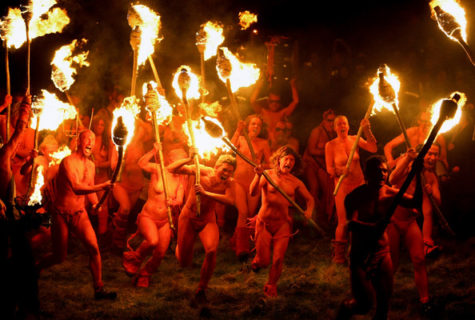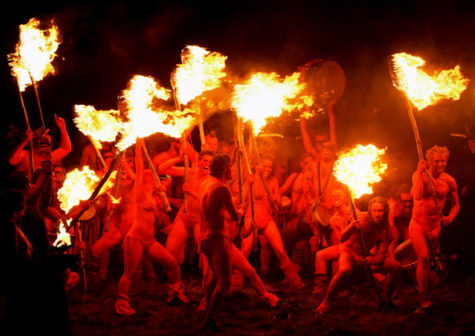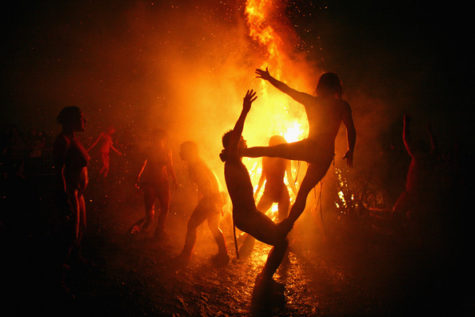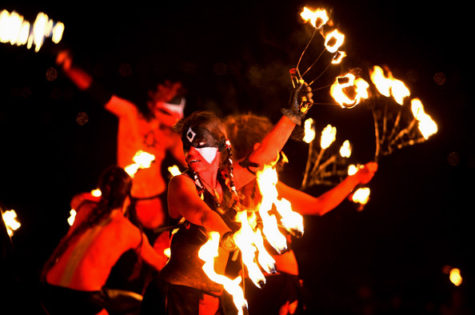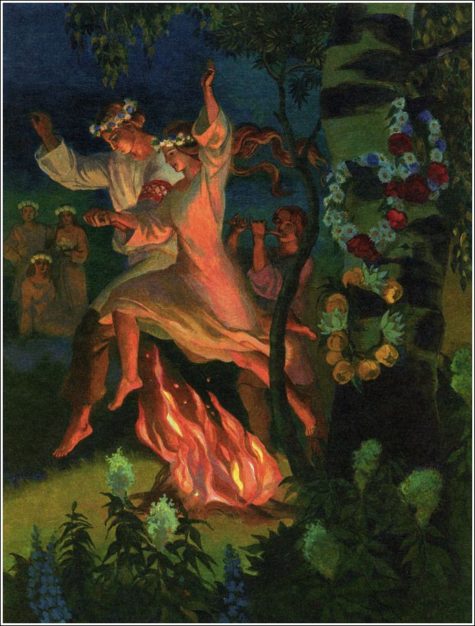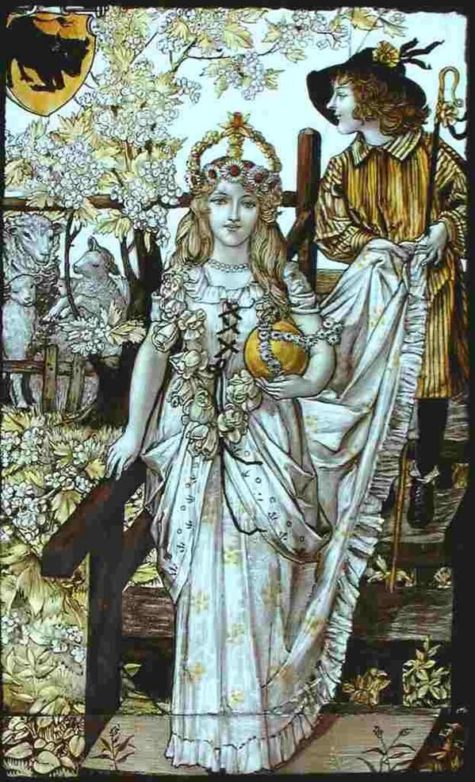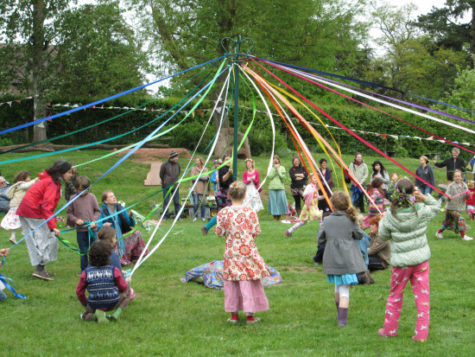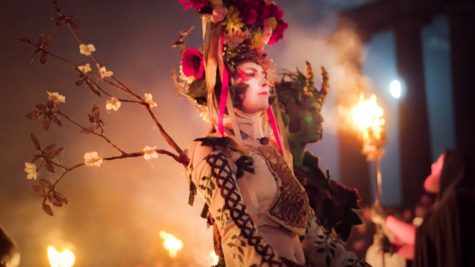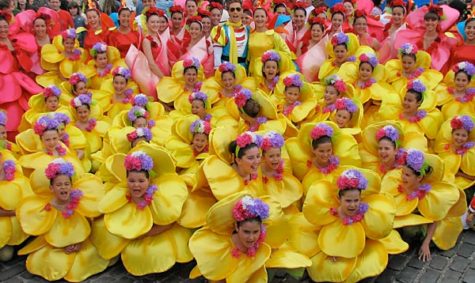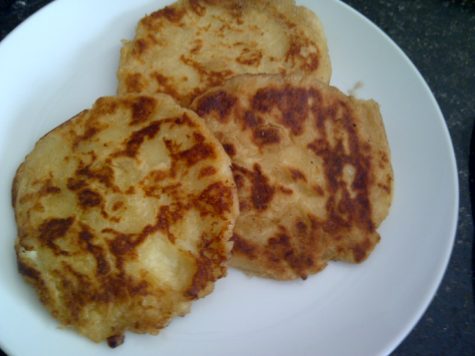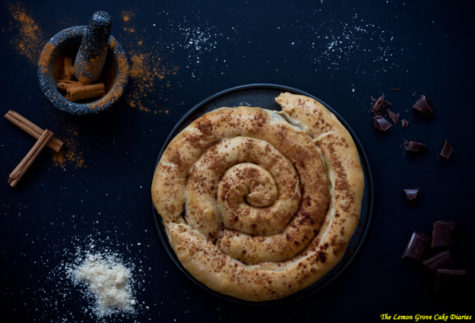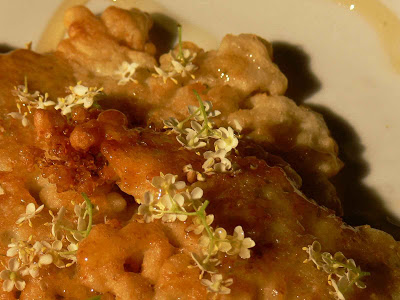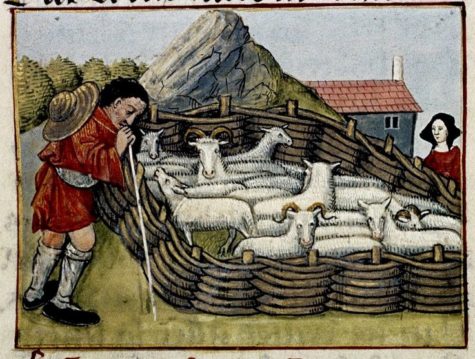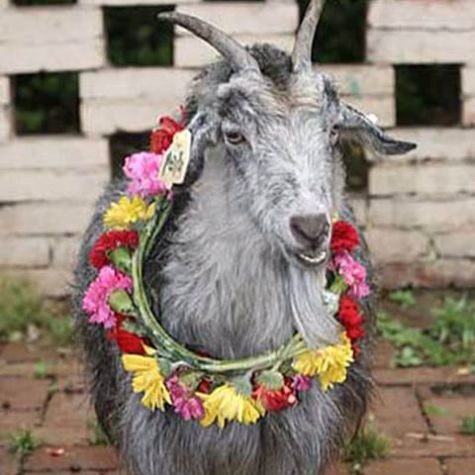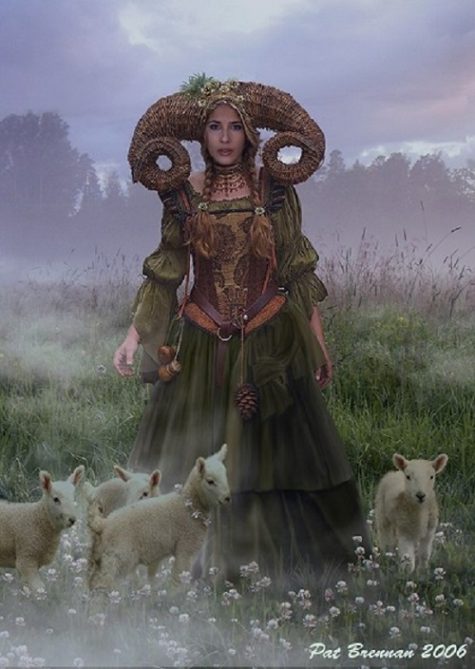Monthly Archives: April 2017
In Germany, Walpurgisnacht (or Hexennacht, meaning witches´ night), the night from April 30 (May eve), is the night when allegedly the witches hold a large celebration on the Blocksberg (the highest of the Harz Mountains of north central Germany) hold revels with their Gods, and await the arrival of Spring.
In some parts of northern coastal regions of Germany, the custom of lighting huge Beltane fires is still kept alive, to celebrate the coming of May, while most parts of Germany have a derived christianized custom around Easter called “Easter fires”.
In rural parts of southern Germany it is part of popular youth culture to go out on Walburgisnacht to play pranks on other people, like messing up someone’s garden, hiding stuff or spraying messages on other people’s property. Sometimes these pranks go too far and may result in serious willful damage to property or bodily injury.
Walpurgis (sw: Valborg) is one of the main holidays during the year in both Sweden and Finland, alongside Christmas and Midsummer. The forms of celebration in Sweden vary in different parts of the country and between different cities. One of the main traditions in Sweden is to light large bonfires, a custom which is most firmly established in Svealand, and which began in Uppland during the 18th century. An older tradition from Southern Sweden was for the younger people to collect greenery and branches from the woods at twilight, which were used to adorn the houses of the village. The expected reward for this task is to be paid in eggs.
Today in Finland, Walpurgis Night (Vapunaatto) is, along with New Year’s Eve, the biggest carnival-style festivity that takes place in the streets of Finland’s towns and cities. The celebration is typically centered on plentiful use of sparkling wine and other alcoholic beverages. The student traditions are also one of the main characteristics of “Vappu“. From the end of the 19th century, “Fin de Siècle“, and onwards, this traditional upper class feast has been co-opted by students attending university, already having received their student cap. Many people who have graduated from lukio wear the cap.
One tradition is drinking sima, whose alcohol content varies. Fixtures include the capping of the Havis Amanda, a nude female statue in Helsinki, and the biannually alternating publications of ribald matter called Äpy and Julkku. Both are sophomoric; but while Julkku is a standard magazine, Äpy is always a gimmick. Classic forms have included an Äpy printed on toilet paper and a bedsheet. Often the magazine has been stuffed inside standard industrial packages such as sardine-cans and milk cartons. The festivities also include a picnic on May 1st, which is sometimes prepared in a lavish manner.
The Finnish tradition is also a shadowing of the Soviet Era May Day parade. Starting with the parties of the left, the whole of the Finnish political scene has nominated Vappu as the day to go out on stumps and agitate. This does not only include right-wing parties, but also others like the church have followed suit, marching and making speeches.
In Sweden it is only the labor and socialist parties which use May 1 for political activities, while others observe the traditional festivities. The laborers who were active in the 1970’s still party on the first of May. They arrange carnivals and the radio plays their old songs that workers liked to listen to. The labor spirit lies most in the capital of Finland, Helsinki.
The First of May is also a day for everything fun and crazy: children and families gather in market places to celebrate the first day of the spring and the coming summer. There are balloons and joy, people drink their first beers outside, there are clowns and masks and a lot of fun. The first of May includes colorful streamers, funny and silly things and sun. The first of May means the beginning of the spring for many people in Finland.
Traditionally May 1st is celebrated by a picnic in a park (Kaivopuisto in the case of Helsinki). For most, the picnic is enjoyed with friends on a blanket with good food and sparkling wine. Some people, however, arrange extremely lavish picnics with pavilions, white table cloths, silver candelabras, classical music and lavish food. The picnic usually starts early in the morning, and some hard-core party goers continue the celebrations of the previous evening without sleeping in between. Some Student organisations have traditional areas where they camp every year and they usually send someone to reserve the spot early on. As with other Vappu traditions, the picnic includes student caps, sima, streamers and balloons
The tradition which is most widespread throughout the country is probably singing songs of spring. Most of the songs are from the 19th century and were spread by students’ spring festivities. The strongest and most traditional spring festivities are also found in the old university cities, like Uppsala and Lund where both current and graduated students gather at events that take up most of the day from early morning to late night on April 30, or “sista April” (“The last day of April”) as many people call it. There are also newer student traditions like the carnival parade, The Cortège, which has been held since 1909 by the students at Chalmers in Gothenburg. In Sweden, Valborg is especially notorious because of the excessive amounts of alcohol people consume on that day.
Found at: Nation Master
Here’s how they celebrate Beltane in Edinburgh!
Enjoy!
First organized in the 1980’s, the Beltane Fire Festival has become a popular festival in Edinburgh. Here we have photos of the Beltane Fire Society celebrating Spring and the coming of summer. This lively procession celebrates the ending of winter and is a revival of the ancient Celtic festival of Beltane which is the Gaelic name for the month of May. More about Beltane can be found here: Beltane
The first of May is Beltane or May Day, a time to celebrate the leaping fires of passion. Traditionally celebrated on April 30, (May eve), it marks the height of spring and the flowering of all life. Beltane is a festival of sensuality, sexuality, flowers and delight. It is a traditional time to make love, preferably outdoors.
Beltane is the time when fairies return from their winter rest, carefree and full of mischief and delight. On the night before Beltane, in times past, folks would place rowan branches at their windows and doors for protection. If you do not wish the fairies to visit, do the same! This is also a perfect time for night or predawn rituals to draw down power to promote fertility in body and mind.
At Beltane, the Pleiades star cluster rises just before sunrise on the morning horizon. The Pleiades is known as the seven sisters, and resembles a tiny dipper-shaped pattern of six moderately bright stars in the constellation of Taurus, near the shoulder. Watch for it low in the east-northeast sky, just a few minutes before sunrise.
There are many lovely old customs associated with this time. Here are some simple ideas for celebrating this wild red time of year:
- Make a garland or wreath of freshly picked flowers and wear it in your hair.
- Dress in bright colors, especially hot pink or crimson, the traditional colors of Beltane, or wear green all day (and nothing all night!)
- Hang fruits and baked goodies from trees and bushes for later feasting.
- Build a Beltane fire: leap over it to cleanse yourself, or state your desires and let the fire carry them upward.
- Leap over your garden rows (or house plants), sharing joyous energy.
- Make a ‘May gad’: peel a willow-wand and twine cowslips or other flowers around it.
- Throw a May Day party and feast on May wine and food till the dawn. Turn a broomstick into a maypole and see how many people you can get to dance round it.
- Make love in the woods, in your garden, outside – at night.
- Watch the sunrise. Pack a picnic breakfast, a blanket, and some sweaters; and head out before dawn. Unpack your picnic on a hill with an unobstructed view and enjoy the early morning rays as the sun peaks over the horizon.
- Make a flower feast! Freeze edible flowers in your ice cubes. Add edible flowers to your salad. Candy flowers to decorate your dessert.
- Make a May basket. Fill it with flowers, food, ribbons, and fun. Leave it on a doorstep of a lover or friend, or someone who cannot get outside, such as an invalid or elderly person.
- Make a daisy chain and cast it into one of the lakes to please the water spirits.
- Rise at dawn on May Day and wash in the morning dew: The woman who washes her face in it will be beautiful, the man who washes his hands will be skilled at knots and nets (always a useful skill for students).
- Twist a Rowan sprig into a ring and look through it- tonight is one of the three in the year when the uninitiated can see the faeries.
- Create a May Day altar with a mirror, a small maypole, a phallic shaped candle, a daisy chain and springtime flowers.
- Light a fire or candle on the top of a hill and make a wish as you jump over it (for authenticity, you can try this sky clad, it would also be amusing for any passing late-night dog walkers!)
- Perfume your house with delicate scent of woodruff, a tiny, star-like flower that blooms around this time in the Northern Hemisphere.
- Embrace the ones you love. Hugs and kisses all around.
Holidays are days made holy by the attention we pay them. Simple practices such as the ones listed above remind us that we too dance to the natural rhythms of the earth.
Honor The May Queen
Make an offering of a floral crown, or a libation of honey and milk, to the Queen of the May during your Beltane prayers.
The leaves are budding across the land
on the ash and oak and hawthorn trees.
Magic rises around us in the forest
and the hedges are filled with laughter and love.
Dear lady, we offer you a gift,
a gathering of flowers picked by our hands,
woven into the circle of endless life.
The bright colors of nature herself
blend together to honor you,
Queen of spring,
as we give you honor this day.
Spring is here and the land is fertile,
ready to offer up gifts in your name.
we pay you tribute, our lady,
daughter of the Fae,
and ask your blessing this Beltane.
Make A Maypole for Beltane
This isn’t as difficult as you might think. Purchase a twenty foot wood pole from your local hardware store, or make a shorter one with a yardstick, broomstick, or even a twig. Set it up in your backyard.
Invite a group of friends, and ask each one to bring a 2 inch by 20 foot length of brightly colored ribbon (or whatever the length of your pole). Alternatively, you could provide ribbons of various colors. At the top of the pole affix the different colored ribbons – one for each person.
When your guests have assembled, have them each choose a ribbon and make a wish upon it.(For example, “I choose this red ribbon for more passion in my life.”) Everyone grabs their ribbon, and the dancing begins. (Make sure to have extra ribbons just in case!) Dance around the Maypole entwining your ribbons together. And then feast on May wine and food till the dawn.
More About Beltane
For the Celts, Beltane marked the beginning of the pastoral summer season when the herds of livestock were driven out to the summer pastures and mountain grazing lands. In modern Irish, Mí na Bealtaine (‘month of Bealtaine’) is the name for the month of May. The name of the month is often abbreviated to Bealtaine, with the festival day itself being known as Lá Bealtaine. The lighting of bonfires on Oidhche Bhealtaine (‘the eve of Bealtaine’) on mountains and hills of ritual and political significance was one of the main activities of the festival.
Beltane is a cross-quarter day, marking the midpoint in the Sun’s progress between the vernal equinox and summer solstice. Since the Celtic year was based on both lunar and solar cycles, it is possible that the holiday was celebrated on the full moon nearest the midpoint between the vernal equinox and the summer solstice. The astronomical date for this midpoint is closer to May 5 or May 7, but this can vary from year to year.
In Irish mythology, the beginning of the summer season for the Tuatha Dé Danann and the Milesians started at Bealtaine. Great bonfires would mark a time of purification and transition, heralding in the season in the hope of a good harvest later in the year, and were accompanied with ritual acts to protect the people from any harm by Otherworldly spirits, such as the Sídhe.
Like the festival of Samhain, opposite Beltane on Oct. 31, Beltane was a time when the Otherworld was seen as particularly close at hand. Early Gaelic sources from around the 10th century state that the druids of the community would create a need-fire on top of a hill on this day and drive the village’s cattle through the fires to purify them and bring luck (Eadar dà theine Bhealltainn in Scottish Gaelic, ‘Between two fires of Beltane’).
In Scotland, boughs of juniper were sometimes thrown on the fires to add an additional element of purification and blessing to the smoke. People would also pass between the two fires to purify themselves. This was echoed throughout history after Christianization, with lay people instead of Druid priests creating the need-fire.
The festival persisted widely up until the 1950s, and in some places the celebration of Beltane continues today. A revived Beltane Fire Festival has been held every year since 1988 during the night of 30 April on Calton Hill in Edinburgh, Scotland and attended by up to 15,000 people (except in 2003 when local council restrictions forced the organizers to hold a private event elsewhere).
Wiccans and Wiccan-inspired Neopagans celebrate a variation of Beltane as a sabbat, one of the eight solar holidays. Although the holiday may use features of the Gaelic Bealtaine, such as the bonfire, it bears more relation to the Germanic May Day festival, both in its significance (focusing on fertility) and its rituals (such as maypole dancing). Some Wiccans celebrate ‘High Beltaine’ by enacting a ritual union of the May Lord and Lady.
~Information from various sources including Paganwiccan
The Romans had a celebration for just about everything. Certainly, any deity worth their salt got a holiday of their own, and Flora was no exception. She was the goddess of spring flowers and vegetation, and one of many fertility goddesses. In fact, she was so well respected as a fertility deity that she was often seen as a the patron deity of Roman prostitutes.
Her holiday originated around 235 b.c.e. It was believed that a good festival ensured that Flora would protect the blooming flowers around the city. However, at some point the celebration was discontinued — but it clearly took its toll when wind and hail did some serious damage to the flowers of Rome. In 173 b.c.e., the Senate reinstated the holiday, and renamed it the Ludi Floralis, which included public games and theatrical performances.
The Floralia took place during the five days between April 28 and May 3. Citizens celebrated with drinking and dancing. Flowers were everywhere, in the temples and on the heads of revelers. Anyone making an offering to Flora might give her a libration of milk and honey.
source: PaganWiccan
Oats and oat cakes are still used today in Beltane celebrations, especially in Scotland where the tradition originated. Therefore, oats have been widely accepted as a very appropriate Beltane food, good for fertility and luck. This recipe for Farls, was popular in northern Ireland and Scotland, incorporating the ever-popular potatoes as well (with the oats!). Best of all, it’s gluten free!
Ingredients:
- 3 cups real mashed potatoes
- 2 cups dry oats
- 2 tablespoons butter or margarine
- 1/2 teaspoon cornstarch
- 1/2 teaspoon baking powder
- 1/8 teaspoon salt
- Pinch of pepper
- Pinch of rosemary (optional)
Directions:
Soak the oats in warm water for 15 to 20 minutes. (Use the amount of water your oats package tells you to use as if for cooking.) Drain the oats if there is extra water at the end of their soaking, then mix the potatoes and other ingredients into the bowl. Knead it together until a dough forms. If it’s still too moist, add flour until it can be picked up and shaped. Form into round patties. Fry in hot vegetable oil until lightly browned and serve immediately.
NOTE:
They seem to cook best if you put them in the pan and don’t smush them down with the spatula on their first side. When you flip them over, that’s when you can smush them down a little, because they’ve got a cooked surface that won’t get stuck to your spatula.
Yield: 8 servings
Source: Sabbats
The serpent or snake is a symbol of May because of its ancient association with fertility. This association dates back to the earliest Pagan religions, and though later religions cropped up casting the serpent in a deceitful role, the Earth religions still honor the snake as a blessed creature this time of year. Its way of slithering along the body of the Earth made it an obvious phallic symbol, and May Day is full of such symbols (the maypole being the most well-known one).
The holiday of Beltane comes on the first of May and encourages those who celebrate life to greet spring’s bounty with festivities, and that of course always involves food. This snake-shaped cake, incorporating appropriate seasonal ingredients, is a wonderful addition to a party table.
Ingredients:
- 3/4 cup sugar
- 1/2 teaspoon ground cloves
- 1 1/2 teaspoons ground nutmeg
- The zest of one orange
- 1 teaspoon baking soda
- 3/4 teaspoon salt
- 4 1/2 cups plus 2 tablespoons flour
- 1/2 cup butter
- 3/4 cup plus 3 tablespoons honey, boiling
- 1/2 cup strong espresso coffee
- 1 egg
- 1/3 cup amaretto or rum
- /3 cup wild cherry or raspberry jam
- Garnish: 4 coffee beans and some candied orange peel, in slices
Directions:
Preheat the oven to 400º F. Mix the sugar, spices, zest, soda, and salt into the flour in a bowl. Cut in the butter until little pebbles form. Pour in the honey, coffee, and liqueur, and mix in the egg. Mix the batter until everything is evenly distributed and you have a nice soft dough. Let it cool.
Turn it out onto a floured surface and divide in half. Roll one half into an 18-inch rope. Make a deep trough down the center and fill it with jam. Seal it by bringing the edges up over the jam and pressing the seam together. Then flip it seam-side-down onto a parchment-paper-covered baking sheet. Arrange the snake in a circle, but don’t press the ends together. Make one end tapered like the end of a snake’s tail, and make the other end triangular like a snake’s head.
Press in coffee beans for eyes and orange rind for scales if desired. Repeat this process with the other half of the dough and bake them for 30 minutes.
Yield: 2 snake cakes.
Source: Beltane, by Grimassi
This is a very crusty and somewhat dry bread that is incredibly delicious and almost pastry-like in its sweetness. It is ideal for May Day/Beltane celebrations.
Ingredients:
- 1 envelope active dry yeast
- 1/3 cup real maple syrup
- ¼ cup warm water (105ºF-115ºF)
- 3 cups flour
- 3 tablespoons packed brown sugar
- 1 tablespoon baking powder
- ½ teaspoon salt
- ¼ cup shortening
Directions:
Dissolve yeast in the water. Mix 1 ½ cups of the flour with the brown sugar, baking powder, and salt. Cut in shortening. Dissolve the syrup into the yeast mix too. Add yeast mix to the flour mix; stir. Add flour until dough is easy to handle. Turn onto a floured surface and knead for 1 minute. Cover and let rise for 15 minutes. Form into round, place on cookie sheet. Let rise in a warm spot for 30 minutes.
Preheat oven to 350ºF. Slice pleasing image into bread top. Bake for 30 minutes. Bread is done when it sounds hollow when tapped. Loaf can be brushed with syrup or butter during last 5 minutes of baking.
NOTE: Your bread will have trouble rising if the syrup is too cold! Warm up the syrup if it has been in the refrigerator, it should be room temperature or warmer.
Yield: 1 loaf
Source: A Kitchen Witch’s Cookbook
Fritters are a nice variation on pancakes, and the bonus for this particular recipe is that they are sweet without any additions, requiring no syrup, sugar or jam. Many people have had fritters of various types, especially the popular apple variety. But . . . “elder flower” fritters? Yes, these actually contain elder flowers!
Flowers were a common ingredient in cooking during medieval times, which is where this recipe comes from (England, specifically). In this recipe’s case, the flowers mixed into the batter help add a kick and a minty taste.
Because of the elder flowers, these sweeties have been associated with faeries in folk myths. Because of that, they have been used at Pagan celebrations of Beltane, Litha, and Lughnasadh to help as a protection against the malevolent and mischievous fair folk, and sometimes these are even made at Samhain season as a symbol of keeping away bad spirits.
If you’ve never made a recipe incorporating flowers before, you might start with this one–you’ll be pleasantly surprised! (Read on after the directions for variations and notes.)
Ingredients:
- 1 egg
- 1 teaspoon rose water
- 1/2 cup honey
- 2 tablespoons brandy
- 1 cup self-rising flour
- 1/4 teaspoon cinnamon
- 2 cups elder flowers, freshly picked and cleaned
Directions:
Mix egg, rose water, honey, and brandy in a bowl, then stir in flour and cinnamon. Should be thick like pancake batter. (Add flour if it’s too thin, and add more brandy if it’s too thick.) Fold in the flowers. Fry like pancakes, OR drop by the teaspoonful into a deep-fat fryer until golden brown. Serve with orange water sprinkle and fresh lemon, or dip in sweet cream.
Yield: Fried like pancakes: About 10. Deep fat fryer: About 2 dozen.
Use for: Beltane, Litha, Lughnasadh, Samhain, The Floralia
Source: A Kitchen Witch’s Cookbook
Note: In many areas it may be tough to find fresh elder flowers. If you order from somewhere or pick them yourself, make sure they are the Nigra variety because there is a kind you shouldn’t use due to high toxicity.
IF YOU CANNOT FIND ELDER FLOWERS or you are squeamish about eating flowers, there is a variation:
You can make this recipe by substituting very finely diced apples–about a cup’s worth–for the flowers, and adding a little fresh mint. If you do do this substitution I urge you to not neglect the mint, because with either elder flowers or with apple-and-mint, the minty taste is really what makes it so good.
- 1 cup sweet woodruff
- 2 bottles rose’ wine
- 4 dozen rose petal ice cubes
- 1 quart strawberries
- 1 quart chopped peaches
- 1 cup sugar
- 1/2 cup white rum
- 2 bottles champagne
- 1 bottle white wine
- 1 liter lemon-lime soda
Two weeks before serving: clean woodruff and pack into one bottle of wine. Cork and let sit.
The day before serving: make four dozen ice cubes by placing rose petals in the compartments before adding water. Freeze until solid.
Hull and wash the strawberries. Slice. Mix peaches and strawberries. Add sugar and rum. Marinate overnight.
An hour before serving: Strain woodruff out of wine and discard leaves. Mix champagne, all remaining wine, lemon-lime soda, and fruit in a large bowl. Stir.
Add ice cubes 15 minutes before serving. Serves 20.
Dancing with the Sun
by Jasmine Yalenorn
Also called The Parilia, this festival is dedicated to the Another festival to Pales, goddess of herds. In ancient Roman religion, Pales was a deity of shepherds, flocks and livestock. Regarded as male by some sources and female by others, Pales can be either singular or plural in Latin, and refers at least once to a pair of deities.
During these festivals, ritualistic cleansing of sheep/cattle pens and animals would take place. There are two dates for this festival, one is April 21, and the other on July 7. The festival in April was for smaller livestock, while the one in July was for larger animals.
The festival, basically a purification rite for herdsmen, beasts, and stalls, was at first celebrated by the early kings of Rome, later by the pontifex maximus, or chief priest.
The Vestal Virgins opened the festival by distributing straw and the ashes and blood of sacrificial animals. Ritual cleaning, anointment, and adornment of herds and stalls followed, together with offerings of simple foods.
Shepherds swept out the pens and smudged the animals and pens with burning sulfur. In the evening, the animals were sprinkled with water, and their pens were decorated with garlands. Fires were started, and in were thrown olives, horse blood, beanstalks without pods, and the ashes from the Fordicalia fires. Men and beasts jumped over the fire three times to purify themselves further, and to bring them protection from anything that might harm them (wolves, sickness, starvation, etc.). After the animals were put back into their pens the shepherds would offer non-blood sacrifices of grain, cake millet, and warm milk to Pales.
Another description of this Festival from Nova Roma is as follows:
The Parilia is both an ancient agricultural festival sacred to Pales and the birthday of Eternal Roma Herself. The sheep-fold is decorated with greenery and a wreath placed on its entrance. At first light the fold is scrubbed and swept, and the sheep themselves are cleansed with sulfur smoke. A fire is made of olive and pine wood, into which laurel branches are thrown; their crackling is a good omen. Offerings are made of cakes of millet, other food, and pails of milk.
A prayer is then said four times to Pales (while facing east), seeking protection and prosperity for the shepherd and his flocks, forgiveness for unintentional transgressions against Pales, and the warding off of wolves and disease. The shepherd then washes his hands with dew. Milk and wine is heated and drunk, and then he leaps through a bonfire (and possibly his flocks as well).
Day of Pales Ritual
From the Pagan Book of Hours, we have a modern day ritual for the Day of Pales.
- Color: Sand-colored
- Element: Earth
- Altar: Upon a sand-colored cloth set a man’s right shoe and a woman’s left shoe, side by side, with a shepherd’s crook between them, and small figures of goats and sheep.
- Offerings: Work in the barn with livestock. Do some chore or work-task that you were taught was inappropriate for your gender.
- Daily Meal: Goat. Lamb or mutton. Coarse bread. Soup or stew. Greens.
Invocation to Pales
Hail, Keeper of Flocks and Herds,
Ass-headed god/dess, you who are
Both male and female,
Both god and peasant,
Patron of those who must dirty their hands,
Beloved of the working man and woman,
You who do not play favorites,
Trickster who loves a good joke,
Lord of the dry land between the rivers
Where your flocks graze on scrub
And the people’s blood flows like water
In their everlasting feud,
Come to us and show us life
Through your crooked ass eyes!
Hail, Keeper of Flocks and Herds,
Lady/Lord of the crook and sandals,
You show us that roles
Are meant to be transgressed,
That work can be radical,
That being bound to the labor of the Earth
Does not have to make one heavy.
We need your humor, divine ass!
We need your braying laughter to echo
Over the desert and through our hearts,
And to watch you tip the balance of power
Like a child tips an apple cart.
Hail, Keeper of Flocks and Herds!
(After the invocation, go to the barn, or to a local farm. Hoofed livestock should be given treats on this day, in honor of Pales.)
